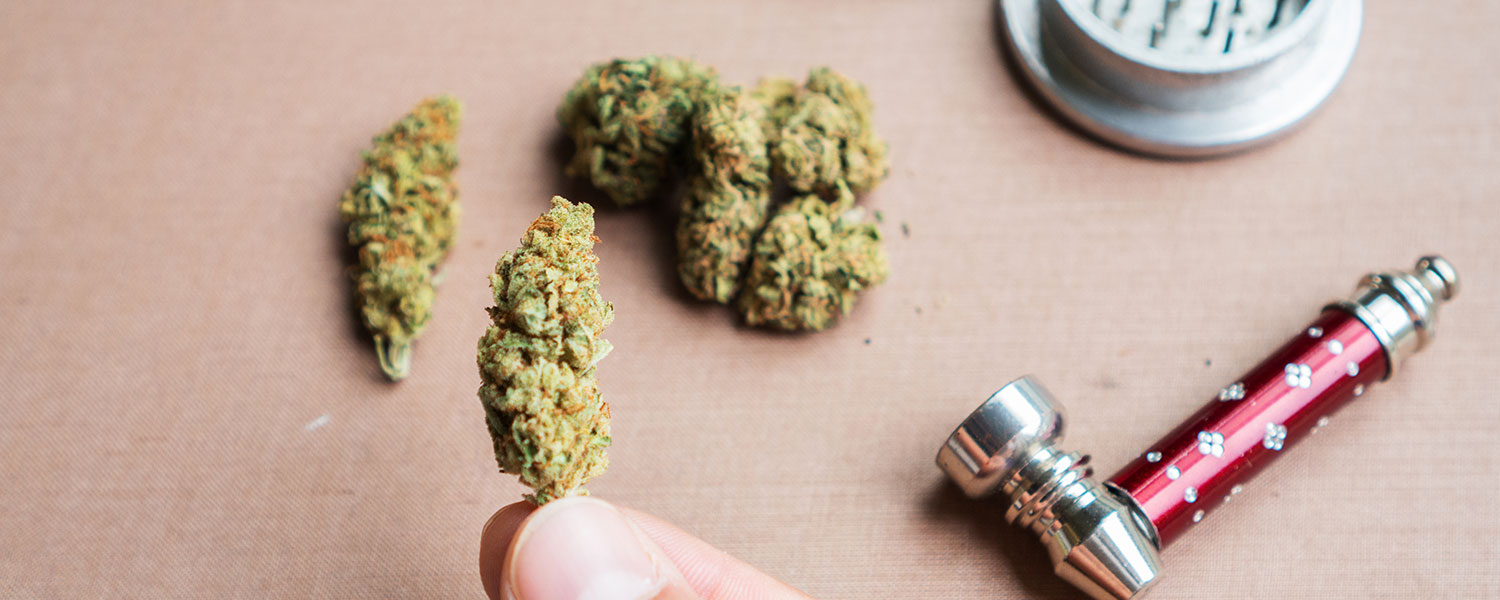In This Article
- What is a Weed Bowl?
- Which Smoking Devices Have Bowls?
- Hand Pipes
- Bongs
- Steamrollers
- One-Hitters and Chillums
- DIY and Novelty Bowls
- Do Materials Matter?
- Glass
- Metal
- Wood
- Stone
- Silicone
- How to Choose the Right Bowl
- How to Pack and Smoke a Bowl
- Step 1: Pack It
- Step 2: Smoke It
- Frequently Asked Questions
- What is a weed bowl called?
- Is it a bowl or a pipe?
- What’s better: a joint or a bowl?
- What’s the world’s largest weed bowl?
Key Takeaways
- Weed bowls are timeless, blending function, culture, and history.
- Bowls come in a variety of sizes and materials.
- Consumers choose their bowls based on several factors, including material, design, size, and budget.
The bowl remains a cornerstone of cannabis consumption and culture, offering versatility, efficiency, and aesthetic appeal. Combining function with artistry, it’s no wonder why it remains a fixture in cannabis communities despite waves of innovation expanding smoking options.
Selecting the right bowl is integral to repeat enjoyable experiences. Consider the finer points below before picking a pipe.
What is a Weed Bowl?
A “weed bowl” refers to both a smoking device and a session of cannabis use. It’s the rounded chamber in a pipe or bong where ground cannabis is packed, lit, and smoked. Options range from simple and mass-produced to intricate, hand-crafted works of art.
Bowls have been used for weed smoking for centuries, with ancient civilizations in Asia, Africa, and the Americas making smoking devices from natural materials such as clay, stone, and wood. Modern designs took off in the 1960s, led by artisans like Bob Snodgrass, whose hand-blown glass pieces shaped today’s cannabis culture.
Today, the bowl’s simplicity and efficiency make it a go-to for beginners and experienced users alike. Beyond its function, it holds cultural significance, with phrases like “smoking a bowl” or “packing a bowl” often serving as shorthand for a classic cannabis session and a nod to community traditions.
Which Smoking Devices Have Bowls?

Bowls can be found in numerous cannabis smoking devices. Some of the most common options include:
Hand Pipes
Hand pipes, sometimes called “spoon pipes,” are classic compact, portable devices. Also referred to as “bowls,” hand pipes typically contain a stem, a bowl, and some holes (like the carb, which creates airflow), including the mouthpiece. Carbs aren’t essential to hand pipes but are commonly included to help control airflow and the size of the hit consumed.
Bongs
Bongs, or water pipes, allow for smoother hits, improved airflow, and easier cleaning. Bowls are typically placed into the bong’s downstem opening, allowing for easy removal when the consumer is ready to inhale the smoke produced. Depending on the bong, bowl sizes will vary, typically requiring a 10mm, 14mm, or even 18mm piece. Today, some bongs are used for vaping, negating the need for cannabis flower and traditional bowls.
Steamrollers
Steamrollers are cylindrical pipes with open ends that create better airflow. Their tube-like design gives them the look of a steamroller, helping them earn their name. These devices are a mix of hand pipes and bongs known for delivering strong hits, ideally suited for seasoned smokers.
One-Hitters and Chillums
One-hitters and chillums are small pipes, typically three inches or less long, with a small, deep bowl. These two often interchangeable options are ideal for quick, solo sessions or for anyone looking to smoke cannabis on the go. Both are also excellent choices for beginners.
DIY and Novelty Bowls
Household items like apples, pineapples, soda cans, or vegetables can be fashioned into temporary DIY smoking devices, and they all require a bowl. On the other hand, some craft pipes are made with intricate designs and components, putting a twist on the classic, straightforward bong and hand pipe.
Do Materials Matter?

A weed bowl’s material can play a significant role in the smoking experience. Before buying or smoking from one, consider how each material could impact the smoke session.
Glass
Glass smoking pipes are the most popular material for weed bowls today due to their clean taste and aesthetic versatility. Their non-porous surface preserves the flavor of cannabis while preventing air, liquids, and other fluids from penetrating their material. Glass is also highly regarded for its visual appeal, including sophisticated designs and the ability to watch smoke fill and leave the bowl with every pull.
Metal
Metal bowls are popular for their durability, portability, and affordability. Nearly indestructible, metal is an ideal choice for outdoor or travel consumption where a standard glass weed pipe may not survive. Despite its positives, drawbacks include reports of a metallic aftertaste, potentially diminishing the quality of the cannabis smoke.
Wood
Wood provides a natural smoking experience, harkening back to some of the earliest materials used. Unlike metal, wood can reportedly enhance the flavor of cannabis with its subtle earthy notes. However, wood requires additional love, including seasoning, which requires burning the bowl to create a protective layer (similar to how you would season a cast iron pan). Additionally, resin buildup is common in wood pieces, likely requiring more regular cleanings than other materials.
Stone
Stone blends the old-era charm of smoking cannabis with sophisticated art and ideal durability. Stone is a durable material, and bowls are often hand-carved, providing consumers with a functional, aesthetically pleasing piece. While the cooler smoking experience is beneficial for the lungs and throat, it’s a heavier material that may present additional challenges for cleaning.
Silicone
Silicone bowls are virtually indestructible, lightweight, and often come in artistic, eye-catching designs. Easy to clean and highly portable, silicone pieces are ideal options for casual consumers and anyone looking to smoke cannabis without buying an expensive piece. However, silicone lacks the traditional appeal, and reports of flavor alterations from the material may deter some consumers.
How to Choose the Right Bowl
Each consumer has their own criteria when selecting the ideal option for them. Those unsure of what to look for should consider these important overarching details:
- Purpose/Size: Before purchasing, consider the regular purpose of any would-be pieces. For example, a small bowl is often suitable for personal use, while larger options are ideal for heavy consumers and/or group smoke sessions.
- Material: Consider the pros and cons of each material listed above and any other options found.
- Design: Simple designs can be both visually appealing and easy to clean. More sophisticated pieces increase the visual appeal but often come with additional components, nooks, and crannies, which can be difficult to clean.
- Budget: Weed bowls vary in price, ranging from $5 and $10 options for basic models to three- and four-figure sums for advanced or particularly aesthetic devices.
Taking a few extra minutes to assess the options should help most consumers identify the ideal piece that satisfies their preferences and budget.
How to Pack and Smoke a Bowl
Prepping and smoking from a bowl is about as easy as it seems, with only a few steps to consider:
Step 1: Pack It
- Grind the cannabis bud into small but not too fine pieces. A weed grinder is ideal and standard, but the process can be completed with several methods, including using scissors or breaking the buds apart by hand.
- Place a larger collection of cannabis at the bottom of the bowl to prevent any finer flower pieces or debris from clogging the pipe or hitting the mouth during inhalation.
- Pack the finer ground cannabis on top, ensuring proper airflow. Do not pack it too densely, as this can clog the airflow.
Step 2: Smoke It
- Cover the carb with your thumb or finger. This will allow the smoke to accumulate in the bowl once it’s lit.
- Light the flower on the edge of the bowl. The chamber will start to fill with smoke. Do not uncover the carb or risk losing the smoke. Likewise, try not to torch too much of the bowl at once for a smaller, easier hit.
- Release the carb and inhale, taking the smoke into the lungs while simultaneously clearing the chamber.
- Repeat until satisfied or the bowl has been fully burnt.
Frequently Asked Questions

What is a weed bowl called?
A hand pipe may be the technical term for a weed bowl. That said, these pieces are known by many names, including but not limited to:
- Bowl
- Spoon pipe
- Piece
- Slide
- Pipe
- Cone
Is it a bowl or a pipe?
It depends on the piece or component in question. The bowl is the specific part of a pipe or bong where cannabis is packed. A pipe refers to the entire device, which includes the bowl, stem, and mouthpiece.
What’s better: a joint or a bowl?
The choice lies with the consumer. Joints are generally highly regarded for their portability, ease of sharing, and ease of disposability. Conversely, bowls are cost-effective, reusable, and easier to pack and prepare for most newcomers. Likewise, bowls may be more potent than joints, as there’s more smoke capacity per hit in a pipe compared to a joint puff.
What’s the world’s largest weed bowl?
In 2018, Jerome Baker Glass by Jason Harris created the world’s largest bong, “Bongzilla,” which measured a staggering 24 feet and weighed 800 pounds. It currently sits at the Cannabition Cannabis Museum in Las Vegas.

The information in this article and any included images or charts are for educational purposes only. This information is neither a substitute for, nor does it replace, professional legal advice or medical advice, diagnosis, or treatment. If you have any concerns or questions about laws, regulations, or your health, you should always consult with an attorney, physician or other licensed professional.




